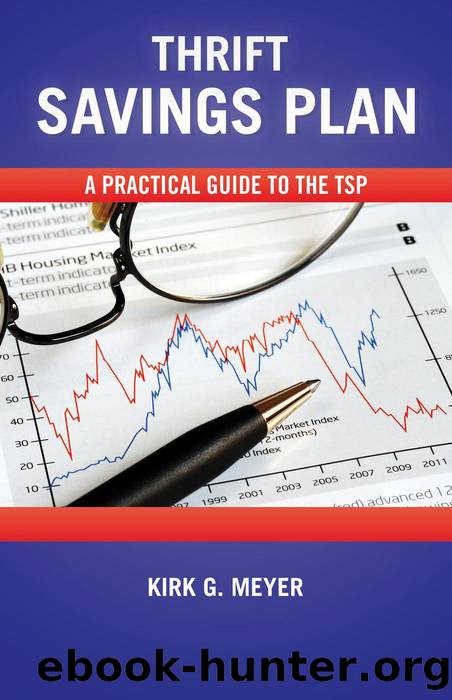Thrift Savings Plan by Kirk G. Meyer

Author:Kirk G. Meyer
Language: eng
Format: epub
Tags: thrift savings plan, thrift savings, tsp, government retirement, government 401(k), government retirement planning, government defined contribution
Publisher: Kirk G Meyer
Published: 2020-08-21T00:00:00+00:00
Comparison of Funds, Risk/Return, and Diversification
As with any investment, the funds in the TSP need to be researched for the participant's comfort level in the risk versus return of the fund. No investment is without risk in today's investment world. Even US Treasuries have inflation risk, though technically they have no credit risk because the US government has never defaulted on its debt. A general rule accepted in investing is that the more risk an investment has, the greater its return. The TSP funds range from investments with little volatility, or risks like the G-Fund, which also has the lowest standard deviation, to more volatile investments such as the S-Fund and I-Fund, which have higher standard deviations and more risks associated with them.
Volatility is basically how likely investment is to have a wide range of prices. Equities have more volatility than corporate bonds, and US federal government-issued bonds are considered low in volatility. As the price of equity can have large-value changes in a single day, it is considered volatile. Where a bond's value is tied to interest rates and length until maturity, its price can change, but interest rate moves are gradual, over some time. These gradual movements make bond funds less volatile than those made up of equities. Using standard deviation is the likelihood that an investment's price will positively or negatively move away from the mean or average of the securities price. The higher the standard deviation is, the more volatile and risky an investment is. Likewise, the higher an investment's standard deviation is, the higher the return needs to be for the investor annually by spreading risk and volatility over several asset classes or investments, reducing the overall risk and standard deviation for the portfolio as a whole.
The G-Fund is the least volatile fund in the TSP that a participant can invest in. Since the fund is in US Treasuries, it does have a very slight risk associated with it and low volatility. The annualized standard deviation for the G-Fund is 0.3%. The fund has a one-year return of 2.24%, a three-year return of 2.49%, a five-year return of 2.27%, a ten-year return of 2.23%, and a return of about 4.4% since 1990. Considering the average inflation rate has been about 3% based on historical averages, the G-Fund, with its low volatility and standard deviation, produces a return about equal to inflation in the short-term and about 1.5% higher than inflation the last 25 years.
The F-Fund is the next lowest in terms of volatility in the TSP and has the next lowest standard deviation. The F-Fund invests in all kinds of domestic bonds offered in the US that are investment grade. The fund tracks the Barclays Capital US Aggregate Bond Index. The annualized standard deviation for the F-Fund is 3.8%. The fund has a one-year return of 8.68%, a three-year return of 4.6%, a five-year return of 3.25%, a ten-year return of 3.99%, and a return of about 6.1% since 1990. Again, this fund over the
Download
This site does not store any files on its server. We only index and link to content provided by other sites. Please contact the content providers to delete copyright contents if any and email us, we'll remove relevant links or contents immediately.
Deep learning with TensorFlow and Keras by Derrick mwiti(883)
Understanding PDA Autism in Kids: A Guide for Parents and Teachers to Support Neurodiverse Learners by Jehu Len(765)
The Victorian Era: A Captivating Guide to the Life of Queen Victoria and an Era in the History of the United Kingdom Known for Its Hierarchy-Based Social Order by Captivating History(549)
Writing Solid Code: Development Philosophies for Writing Bug-Free Programs by Steve Maguire(495)
100 Ideas for Secondary Teachers: Engaging Parents by Janet Goodall & Kathryn Weston(489)
Intersectionality in Educational Research by Dannielle Joy Davis; James L. Olive; Rachelle J. Brunn-Bevel; Susan R. Jones(488)
How to be assertive in any situation by Hadfield Sue & Hasson Gill(477)
Brain Teasers to Build Critical Thinking Skills: Brain Exercises for Tech, Banking, Case Interview Prep, and to Keep Your Mind Sharp by Kris Safarova(464)
Brain Teasers to Build Critical Thinking Skills by Safarova Kris(462)
Python 101 - Fundamentals by Sam(428)
Critical Curriculum Leadership : A Framework for Progressive Education by Rose M. Ylimaki(425)
The Art of Emotional Validation: Improve Your Communication Skills and Transform Your Relationships by Validating Emotions and Feelings by Emily Wright(394)
A Beginner's Guide to SSD Firmware by Unknown(383)
The Knights Templar: An Enthralling History of the Rise and Fall of the Most Influential Catholic Military Order by Wellman Billy(382)
What Every Teacher Should Know about Learning, Memory, and the Brain by Tileston Donna E. Walker;(378)
The Future Knowledge Compendium by Ellyard Peter;(376)
NumPy : From Basic to Advance by bisht Karan Singh(368)
Alma Maters (5th edition) by Unknown(361)
Making Connections in and Through Arts-Based Educational Research by Hala Mreiwed Mindy R. Carter Sara Hashem Candace H. Blake-Amarante(352)
